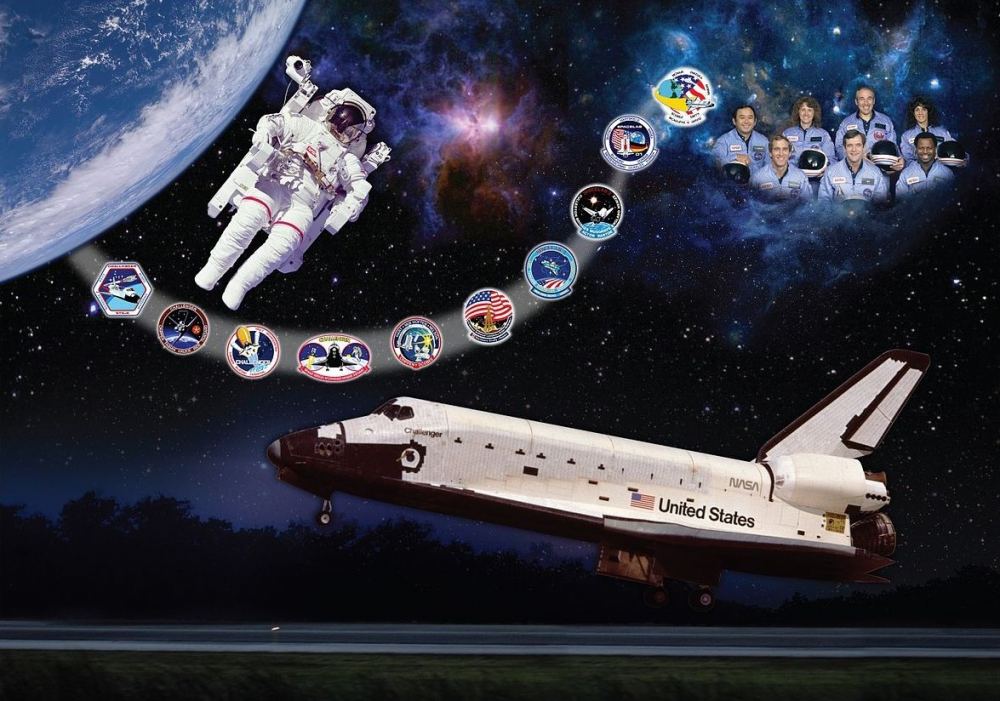

A memorial poster of space shuttle Challenger's orbiter tribute, or OV-099, which hangs in Firing Room 4 of the Launch Control Center at NASA's Kennedy Space Center in Florida. Courtesy NASA.
Nearly 37 years ago the world watched in stunned horror as an explosion destroyed the space shuttle Challenger. The accident occurred 73 seconds after liftoff and killed seven astronauts. Memories of shuttle pieces falling into the sea remain with everyone who witnessed the catastrophe.
In the aftermath, NASA searched for pieces of the shuttle. The agency recovered a great deal of wreckage in the years right after the event. Recently a film crew working on a show for the History Channel discovered a 20-foot-long piece of Challenger on the ocean floor. It was a stunning find and totally unexpected.


The team’s actual goal was to find remnants of ships lost in the Bermuda Triangle. That region actually lies well southeast of the Space Coast. It’s the first major find of wreckage from the disaster in more than 25 years. Underwater explorer and marine biologist Mike Barnette, who led the team, said the crew recognized they had something unique very quickly.
“The significance of this large section of Challenger’s structure was readily apparent,” he said. “We recognized the necessity of bringing this find to the immediate attention of NASA. The site, which is outside of the Bermuda Triangle off the Florida coast, marks the loss of seven brave astronauts—fellow explorers—and the Challenger disaster was a tragic setback for America’s space program. But from this horrific event, important lessons were learned that have ultimately led to remarkable advances in space exploration.”
The team immediately alerted NASA and shared the footage shot by the divers. Agency leaders viewed it and readily agreed that the debris looks very much like a piece of Challenger. NASA administrator Bill Nelson confirmed the find in a public statement.
“While it has been nearly 37 years since seven daring and brave explorers lost their lives aboard Challenger, this tragedy will forever be seared in the collective memory of our country. For millions around the globe, myself included, January 28, 1986, still feels like yesterday,” he said. “This discovery gives us an opportunity to pause once again, to uplift the legacies of the seven pioneers we lost, and to reflect on how this tragedy changed us. At NASA, the core value of safety is – and must forever remain – our top priority, especially as our missions explore more of the cosmos than ever before.”
Space shuttle artifacts such as this one are the property of the U.S. government. The rest of the shuttle is memorialized and ensiloed at Launch Complex 31 at the Cape Canaveral Air Force Station. One piece is on display at the Kennedy Space Center Visitor Complex nearby and lost crews are memorialized there. NASA will work with the families of the astronauts as it decides how to handle the newly found artifact.
The video of the team’s discovery will be part of a program called “The Bermuda Triangle: Into Cursed Waters.” It will air on November 22 as part of a narrative about wreck sites off the coast of Florida.
“The historic and emotional discovery of this Challenger artifact by our incredible team reinforces the HISTORY Channel’s mission to preserve important sites and stories from our national heritage,” said Eli Lehrer, the network’s executive vice president and head of programming. “While the remarkable discovery of wreckage from Challenger was not part of our diving team’s initial mission exploring the Bermuda Triangle, the find’s historical significance cannot be understated.”
NASA Views Images, Confirms Discovery of Shuttle Challenger Artifact
HISTORY Channel Discovers Segment of Space Shuttle Challenger
How can we explore Saturn’s moon, Enceladus, to include its surface and subsurface ocean, with…
Have you ever wondered how astronomers manage to map out the Milky Way when it's…
NASA astronomers have been continuing to monitor the trajectory of asteroid 2024 YR4. The initial…
Some exoplanets have characteristics totally alien to our Solar System. Hot Jupiters are one such…
Stars form in Giant Molecular Clouds (GMCs), vast clouds of mostly hydrogen that can span…
Let’s dive into one of those cosmic curiosities that's bound to blow your mind: how…